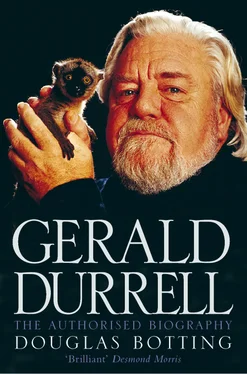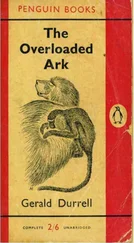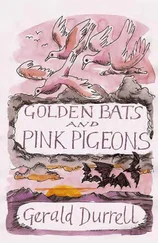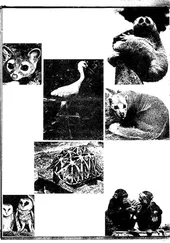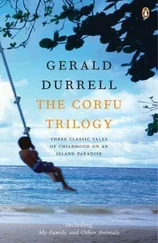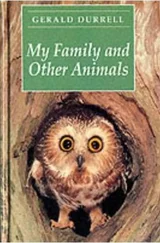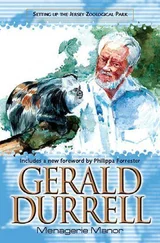In the India of that time it was normal for British servants of the Raj to take a furlough in Britain roughly every two years, but it seems that the Durrells also had a mission to perform during their visit. Lawrence Samuel was keen to find a property to buy in London, either as an investment or as a place to retire to, or both. As a successful engineer of empire he had begun to amass a small fortune, and had already invested in a large fruit farm in Tasmania, which he had purchased unseen. He was now forty-two, and his workload was punishing. Many years later his future (albeit posthumous) daughter-in-law Nancy, first wife of his eldest son Lawrence, was to recall as she lay dying: ‘Father decided he’d had enough of this sort of life and wanted to go to England and live an entirely different sort of life. His ambition was to go on the stage and partner Evelyn Laye in the music hall.’ Whether this was true (which seems improbable) or was one of Lawrence’s numerous canards (which seems very possible), it appears that Father did intend to strike camp at some time, and leave an India where the clamour for self-rule was growing noticeably more vociferous and militant. But not yet. In due course he purchased a suitably grand eight-bedroomed house at 43 Alleyn Park in Dulwich, not far from Lawrence and Leslie’s schools.
On 12 November 192.6 Big Granny sailed back to Bombay on board the SS Rawalpindi after a six-month spell in England. A little later Louisa, Leslie, Margaret and Gerald followed her. They returned not to Jamshedpur but to Lahore, where Lawrence Samuel, who was engaged on contract work in the region, had established a new home in a substantial bungalow at 7 Davis Street. It was in Lahore that such memories as Gerald retained of his life in India were formed – though these were fragmentary and fleeting, and undoubtedly coloured by what his mother, brothers and sister later told him.
From an early age, it seems, Gerald was endowed (like his brother Lawrence) with a highly developed, almost photographic memory. He was to recall in an unpublished memoir:
My handful of memories of this time were just little sharply etched vignettes in brilliant colour, with sight and sound and smell and taste added – the scarlet of the sunsets, for example, the harsh singing cries of a peacock, the smell of coriander and bananas, the tastes of different kinds of rice, especially the wonderful taste of my favourite breakfast, which was rice boiled in buffalo milk with sugar. I remember I used to wear little suits made out of tussore. I remember the lovely colour of it – a very pale biscuit brown – and the delicious soft silky feel of it and the rustling sound it made as my ayah dressed me in the morning. I remember my ayah refused to wake me in the morning unless it was to the strains of Harry Lauder on the gramophone, because otherwise I would be grumpy and morose and she couldn’t do anything with me. The gramophone was a wind-up one and although it was very scratchy, like a lot of mice in a tin box, it was wonderful to my ears, and I would wake up with a beaming smile on my face, which made my ayah heave a sigh of relief.
It was in the India of his infancy that Gerald’s intense sense of colour was born, but it was the young child’s first glimpse of other life forms that was to have the profoundest impact on him. That glimpse was brief and unpromising, but for Gerald it was unforgettable, and from it all else was to follow. He was walking with his ayah, he remembered, and happened to wander to the edge of the road, where there was a shallow ditch.
Here I found two enormous slugs, at least they appeared enormous to me, though they were probably not much more than three or four inches long. They were pale coffee colour with dark chocolate stripes and they were slowly sliding about over each other in a sort of dance and the slime from their bodies made them glitter as though they were freshly varnished. They were glutinous and beautiful and I thought they were the most marvellous creatures I had ever seen. When my ayah discovered I was slug-watching she pulled me away and told me that I must not touch or even watch such disgusting creatures as they were dirty and horrible. I could not understand, even at that age, that she could think such beautiful creatures could be dirty, and throughout my life I have met so many people who think things are disgusting or dirty or dangerous when they are nothing of the sort but miraculous pieces of nature.
Before long the infant Gerald really did set foot inside his first zoo, and his life was transformed for evermore. The zoo was in Lahore (not, as he was later to recall, in Jamshedpur), and the impact of this modest establishment was overwhelming. Gerald was to recall of this landmark in his life:
The rich ammonia-like smell coming from the tiger and leopard cages, the incredible chatter and screams from the small group of monkeys and the melodious song of the various birds that inhabited the little zoo captivated me from the start. I remember the lovely black freckles on the leopard’s skin, and the tiger, as he walked, looking like a rippling golden sea. The zoo was in fact very tiny and the cages minuscule and probably never cleaned out, and certainly if I saw the zoo today I would be the first to have it closed down, but as a child it was a magic place. Having been there once, nothing could keep me away.
According to his mother, ‘zoo’ was one of the first words Gerald ever uttered, and whenever he was asked where he wanted to go he would say ‘zoo’, loudly and belligerently. If he didn’t go to the zoo his screams of frustration could be heard ‘from the top of Everest to the Bay of Bengal’. Once, when he was too ill even to visit the zoo, Gerald was provided with a sort of substitute zoo of his own by the family butler, Jomen, who modelled a whole menagerie of animals – rhinoceros, lion, tiger, antelope – out of red laterite clay from the garden. Perhaps it was this collection of little mud replicas that gave Gerald the idea – that was to become an idée fixe by the time he was six – of having a real zoo of his own one day.
Other creatures that reinforced Gerald’s love of animals made their appearance at this time:
One day my Uncle John, Mother’s favourite brother, a great shikar [hunter] who lived at Ranchi, and was employed by the government to shoot man-eating tigers and rogue elephants, sent us, in a moment of aberration, two fat Himalayan bear cubs. They were weaned but had come straight from the wild and no attempt had been made to tame them. They had very long, sharp claws and very sharp, white teeth and uttered a series of yarring cries of rage and frustration. They were housed temporarily under a big, dome-like basket on the back lawn and a man was detailed to look after them. Of course, having your own bears was a wonderful thing, even though they did smell very lavatorial. Unfortunately, at that age Margaret was ripe for any sort of mischief, and as soon as the bears’ minder went off for some food she would overturn the bears’ basket and then run screaming into the house, shouting, ‘The bears are out! The bears are out!’ After two or three days of this my mother’s nerves could stand no more. She was terrified that the bears would escape and find me sitting on my rug and proceed to disembowel me. So the bears were packed up and sent down to the little zoo.
The long, golden days of Gerald’s privileged infancy, with an army of servants and all the perks of an imperial elite, were to come to an abrupt stop in a tragedy of great consequence for all the Durrells.
Early in 1928 Gerald’s father fell seriously ill. Though the illness was never satisfactorily diagnosed, the symptoms suggest a brain tumour of some kind. Margaret remembered her father suffering from severe headaches, and talking and behaving in a very odd and frightening manner. One day, for example, she was dismayed to see him reach for the inkwell on his desk and drink its contents as if it were a glass of whisky or a cup of tea. Friends and relatives suggested it might help if the ailing man was taken up into the cool of the hills, away from the heat of the Lahore plains, and eventually he was transported to the hill station of Dalhousie, which at a height of nearly eight thousand feet crowned the most westerly shoulder of a magnificent snowy range of the lower Himalayas. Dalhousie had a small English cottage hospital looking out over the mountains, the air was crisp and the ambience calm.
Читать дальше
